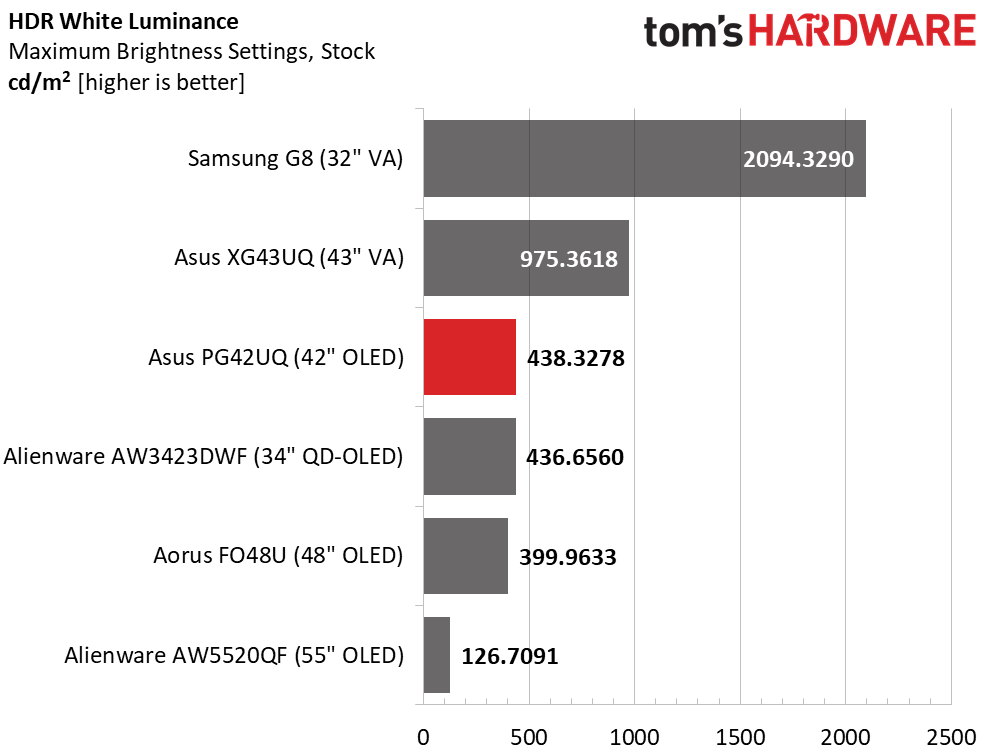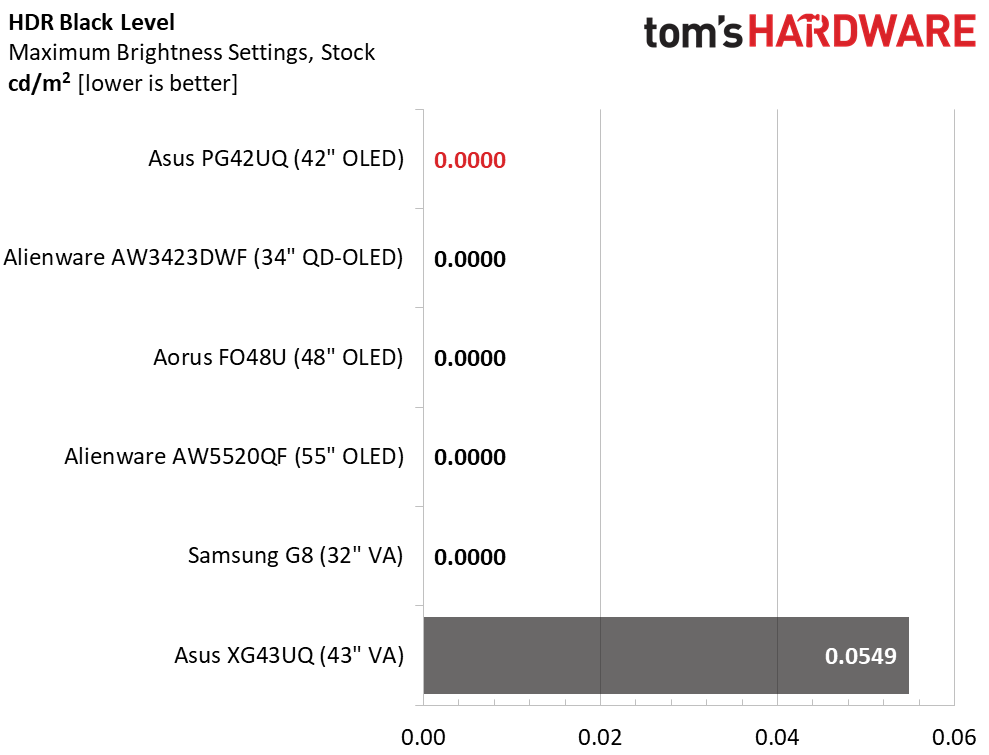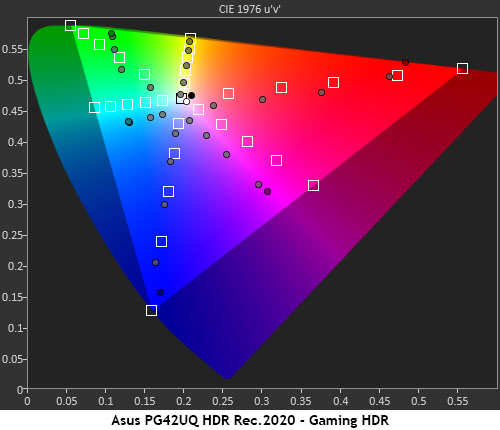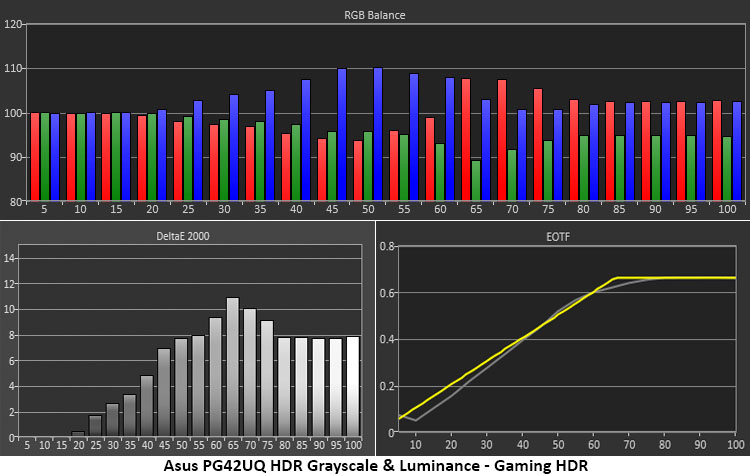Why you can trust Tom's Hardware
Our HDR benchmarking uses Portrait Displays’ Calman software. To learn about our HDR testing, see our breakdown of how we test PC monitors.
OLED and LCD have different advantages when it comes to HDR content. OLED delivers perfect black levels and infinite contrast, while LCD has greater brightness. The choice comes down to personal preference, application and viewing environment. In a typical office, OLED will have the deepest and most realistic picture. The PG42UQ demonstrates this well.
HDR Brightness and Contrast



There are brighter OLED TVs out there, but among desktop examples, the PG42UQ sports average light output. To see 438 nits, I measured a 25% window pattern. A full field comes in around 190 nits, the same as SDR mode.
You may notice that the G8 matches the OLED panels’ zero black level and infinite contrast results. That’s because its Mini LED backlight has its zone dimming feature engaged all the time; it can’t be turned off. In practice, it does a passable job of imitating an OLED, but ultimately, the PG42UQ and its peers deliver the best HDR imagery. While the XG43UQ may look like an also-ran here, its picture is quite good.
Grayscale, EOTF and Color



The PG42UQ offers three HDR modes, Game (the default), Cinema and Console. Game is by far the most accurate and is the one I’m showing here. Grayscale tracking shows some coolness in the mid-tones but good accuracy in the darkest and brightest areas of the image. EOTF tracking is nearly perfect, slightly dark in the lower steps and a smooth transition to tone-mapping at 65%. The other modes mask highlight and shadow detail with inaccurate luminance tracking and are not good choices.
I measured slight under-saturation at the inner targets for red, but other colors are closer to the mark. Green and blue are a little over-saturated. Cyan and magenta are a bit off-hue, but those errors are hard to spot in practice. Similar behavior is seen when the PG42UQ is referenced to Rec.2020. Saturation tracks linearly until the display runs out of color which is as it should be. This is very good performance, and the resulting picture is vivid and bright with sharp delineation between contrasting objects.
MORE: Best Gaming Monitors
Get Tom's Hardware's best news and in-depth reviews, straight to your inbox.
MORE: How We Test PC Monitors
MORE: How to Buy a PC Monitor: A 2022 Guide
MORE: How to Choose the Best HDR Monitor

Christian Eberle is a Contributing Editor for Tom's Hardware US. He's a veteran reviewer of A/V equipment, specializing in monitors. Christian began his obsession with tech when he built his first PC in 1991, a 286 running DOS 3.0 at a blazing 12MHz. In 2006, he undertook training from the Imaging Science Foundation in video calibration and testing and thus started a passion for precise imaging that persists to this day. He is also a professional musician with a degree from the New England Conservatory as a classical bassoonist which he used to good effect as a performer with the West Point Army Band from 1987 to 2013. He enjoys watching movies and listening to high-end audio in his custom-built home theater and can be seen riding trails near his home on a race-ready ICE VTX recumbent trike. Christian enjoys the endless summer in Florida where he lives with his wife and Chihuahua and plays with orchestras around the state.
-
oofdragon "One obstacle to wide acceptance has been size. Early OLED computer monitors weren’t much smaller than big-screen TVs". Article about 42 inch "PC monitor". FailReply -
JarredWaltonGPU Reply
42 inches for 4K on a monitor seems about ideal to me! I felt 30-inch for 1440p was a good size, so if you want to increase the resolution by 125% (1.5X in each dimension), you definitely need to make the screens bigger. This 4K in a 14-inch laptop business is ludicrous, and 4K in a 28-inch monitor isn't much better for practical use.oofdragon said:"One obstacle to wide acceptance has been size. Early OLED computer monitors weren’t much smaller than big-screen TVs". Article about 42 inch "PC monitor". Fail -
Greg7579 Reply
I am a photographer and shoot high-res GFX 100 (100 MP) files. For years I have used an ASUS 32 inch IPS professional monitor that cost me several thousand 5 years ago. I don't render or edit video, and I don't game. I just edit and enjoy my high-res image files and use Photoshop and mostly Lightroom. The color gamut is important to me, but this monitor seems to be right there at the professional level for photography work, and the 42 inch size (up from 32) I think I would relish.Admin said:Asus adds a 42-inch 4K model to the list of available OLED gaming monitors. The ROG Swift PG42UQ sports a 138 Hz refresh rate, Adaptive-Sync, HDR and extended color. It delivers a stunning image and premium gaming performance.
Asus ROG Swift PG42UQ 4K OLED Review: Stunning in Every Respect : Read more
So, should I get this monitor if I never game? I build my own high-end desktop and am about to build a rig with the 4090 just for the Hell of it.
What do I lose when compared to the ASUS pro mini-led monitor that costs 5 grand?
I think I'm going to get this monitor for my photography work and enjoyment.
What do you think? Or is ASUS about to come out with a new "Pro" monitor that is cheaper and better than their current lineup?
I don't need 144 Hz, but why not? Maybe I will even try a game or two. -
hancor ReplyGreg7579 said:I am a photographer and shoot high-res GFX 100 (100 MP) files. For years I have used an ASUS 32 inch IPS professional monitor that cost me several thousand 5 years ago. I don't render or edit video, and I don't game. I just edit and enjoy my high-res image files and use Photoshop and mostly Lightroom. The color gamut is important to me, but this monitor seems to be right there at the professional level for photography work, and the 42 inch size (up from 32) I think I would relish.
So, should I get this monitor if I never game? I build my own high-end desktop and am about to build a rig with the 4090 just for the Hell of it.
What do I lose when compared to the ASUS pro mini-led monitor that costs 5 grand?
I think I'm going to get this monitor for my photography work and enjoyment.
What do you think? Or is ASUS about to come out with a new "Pro" monitor that is cheaper and better than their current lineup?
I don't need 144 Hz, but why not? Maybe I will even try a game or two.
I bought this unit about 2 months ago, and the firmware issue is now resolved. This monitor is everything state of the art, for gaming, photography, or plain old work, net surfing. Currently, paired with my EVGA 2080 Ti, while the EVGA FTW3 RTX Ultra Gaming, is being repaired. Colors just "pop" compared to TN, VA, or IPS panels.
Without question you will enjoy this monitor immensely. Cheers :) -
eisenb11 I have this monitor and it’s great - but I can’t believe that the article didn’t mention fringing on text. IMHO that’s the biggest issue (although you can live with it) with this monitor.Reply
The author is minimizing it by using 150% scaling. He really should have also tested the monitor at 100% scaling so you can, you know, use the full 4K res of the monitor for your desktop.
This is an inherent problem of the WRGB sub pixel layout which pretty much all LG panels use. The real fix is that enough people need to complain about it (not work around it with higher scaling) so Microsoft updates ClearType which is currently optimized for normal RGB.
For those with this monitor, using MacType helps a bit, but a real fix to ClearType is really needed. It improves text quality, but it’s still nowhere near LCD level. You can turn off ClearType, but text looks terrible - even at 4K resolution so that it’s still better looking with the fringing. -
PlaneInTheSky ReplyEven the best Mini LED panels can’t reproduce intra-image black levels like an OLED.
Yep, my OLED has far better local dimming than the Mini LCD TV and none of the light bleeding. Each Mini LED backlight still illuminates thousands of pixels, so Mini LED still suffers from the same problems of IPS, TN and VA panels, light bleeding, no true black, viewing angle problems, etc.
The light bleeding which causes blooming, is less of an issue on TV consuming movies for example. But it is a real issue for text for example.
Only OLED and E-ink solves this problem.
(The exception is of course the QD-OLED garbage from Samsung and Alienware, which messes it all up with their color artefacts.)
The big promise was that Micro LED would solve Mini LED's problems and have per pixel dimming. But Micro LED is turning out to be a manufacturing nightmare. The tiny circuitry needed to power millions of LED is a mess and yields are terrible. -
PlaneInTheSky ReplyI have this monitor and it’s great - but I can’t believe that the article didn’t mention fringing on text. IMHO that’s the biggest issue (although you can live with it) with this monitor.
The Alienware and Samsung QD-OLED have this problem. Color artefacts, color fringes. Whatever people want to call it. They're red and green lines surrounding high contrast elements due to a difference in pixel layout.
I am spared from this problem on my regular OLED TV which I use as a monitor. -
PlaneInTheSky ReplyThis is an inherent problem of the WRGB sub pixel layout which pretty much all LG panels use.
LG sells OLED monitors with an RGB layout that has no color fringing, like the LG Ultrafine Pro series.
Of course, they're more expensive than the OLED screens found in gaming monitors. -
Blacksad999 Interesting review. Every other monitor testing site and reviewer suggested that "Cinema Mode" is the best setting for accurate colors. I'm also curious which firmware the reviewer is using, as people all over the place are dealing with washed out non-functional HDR on firmware V033. All of the previous firmware versions don't allow the panel to wake on sleep if you're using "overclocking" to reach 138hz, and the pixel refresh pop up returns very commonly, so I was surprised to see no mention of any of that.Reply
You can read about the broken HDR in depth on Rtings review of the monitor. The tone mapping is broken on this monitor, and only covers 34% of the gamut when HDR is on, as you can see here: https://www.rtings.com/assets/pages/ncyZeV4m/fall-800-hdr-off-large.jpgIf anyone knows which firmware the reviewer is using, let me know. I don't think it's the updated version V033. -
DougMcC So close to the monitor i'm dying to buy. Just get me to 144hz and no bigger than 37".Reply
